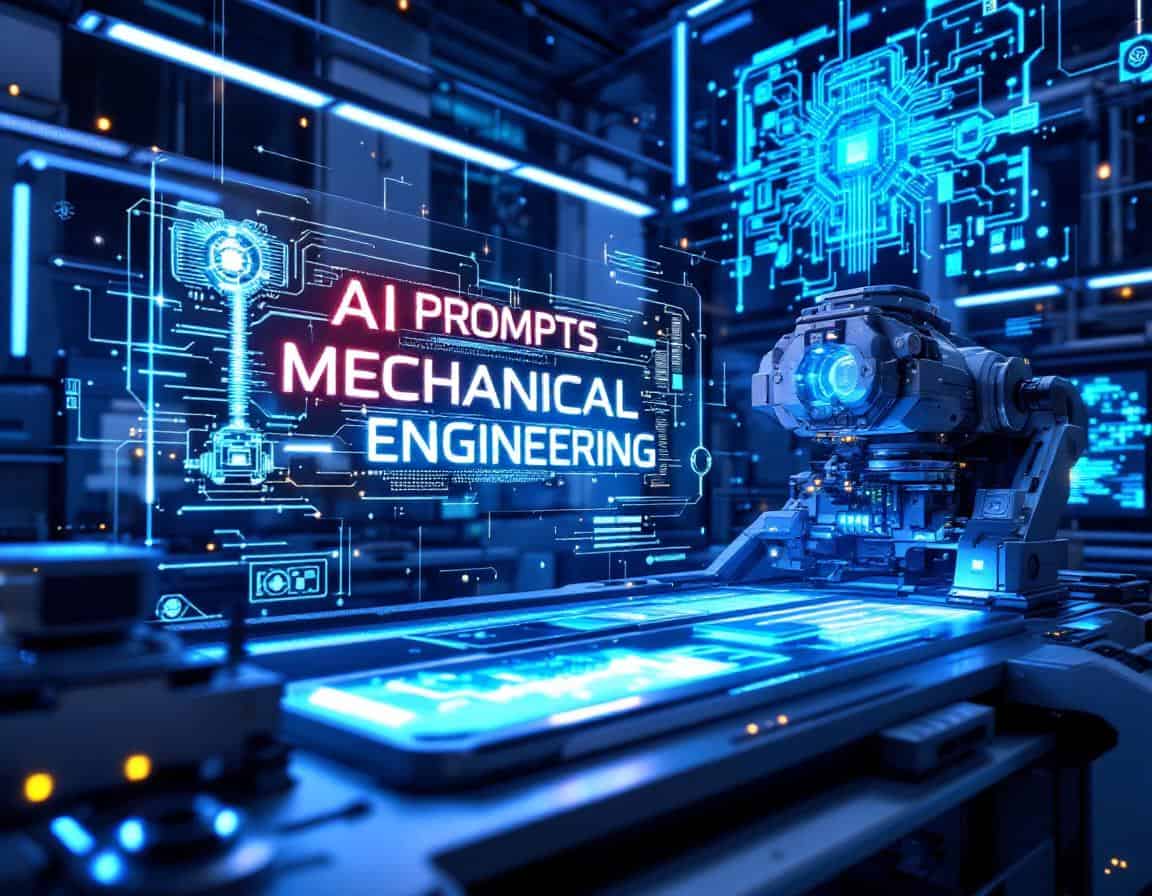
Las herramientas de IA en línea están transformando rápidamente la ingeniería mecánica al aumentar las capacidades humanas en diseño, análisis, fabricacióny mantenimiento. Estos sistemas de IA pueden procesar grandes cantidades de datos, identificar patrones complejos y generar soluciones novedosas mucho más rápido que los métodos tradicionales. Por ejemplo, la IA puede ayudarle a optimizar el rendimiento y la fabricabilidad de los diseños, acelerar simulaciones complejas, predecir las propiedades de los materiales y automatizar una amplia gama de tareas analíticas.
The prompts provided below will for example help on generative design, accelerate simulations (FEA/CFD), help on predictive maintenance where AI analyzes sensor data from machinery to forecast potential failures, enabling proactive servicing and minimizing downtime, help on material selection and much more.
- Esta página es específica para un dominio. Si lo desea, puede realizar búsquedas en todos los dominios y según todos los criterios en nuestro >. Directorio AI Prompts <, dedicado a diseño de producto y innovación.
- Dados los recursos del servidor y el tiempo, los propios avisos están reservados sólo a los miembros registrados, y no son visibles a continuación si no se ha iniciado sesión. Puede registrarse, 100% gratis:
- Análisis de causa raíz
- Ingeniería mecánica
AI Prompt to Diagrama de espina de pescado Entradas por fallo
- Mejora continua, Diseño para la fabricación (DfM), Análisis de fallos, Manufactura esbelta, Ingeniería Mecánica, Mejora de procesos, Gestión de calidad, Análisis de causa raíz, Seis Sigma
Ayuda a estructurar un diagrama de espina de pescado (Ishikawa) para un fallo de un componente mecánico sugiriendo posibles categorías de factores contribuyentes (por ejemplo, Hombre Máquina Material Método Entorno Medición) y preguntas específicas para cada categoría en función de la descripción del fallo. Esta sugerencia facilita un análisis sistemático de la causa raíz. El resultado es un esquema con formato Markdown.
Salida:
- Markdown
- no requiere Internet en directo
- Campos: {component_that_failed} {failure_mode_description} {operating_conditions_at_failure_text}
- Ideal para: Ayudar a los ingenieros mecánicos a investigar sistemáticamente los fallos de los componentes mediante preguntas adaptadas a cada categoría de un diagrama de espina de pescado (Ishikawa).
- Consideraciones éticas y análisis de impacto
- Ingeniería mecánica
AI Prompt to Ethical Framework for Autonomous Machinery
- Sistemas avanzados de asistencia al conductor (ADAS), Inteligencia Artificial (IA), Vehículo autónomo, Pensamiento de diseño, Diseño centrado en el ser humano, Gestión de riesgos, Robótica, Seguridad
Generates a framework for ethical considerations in designing autonomous mechanical systems focusing on safety accountability and decision-making in unforeseen scenarios. This prompt helps engineers proactively address ethical challenges during the design phase of complex machinery. The output is a structured markdown document.
Salida:
- Markdown
- no requiere Internet en directo
- Fields: {autonomous_system_type} {operational_environment_description} {key_decision_making_scenarios_csv}
- Best for: Proactively developing ethical guidelines for autonomous mechanical systems helping engineers navigate complex moral decision-making in design and operation.
- Consideraciones éticas y análisis de impacto
- Ingeniería mecánica
AI Prompt to Esquema de la evaluación del impacto ambiental del ciclo de vida
- Economía circular, Fabricación ecológica, Impacto ambiental, Evaluación de Impacto Ambiental, Ciclo vital, Análisis del ciclo de vida (ACV), Prácticas de sostenibilidad, Desarrollo sostenible, Diseño de productos sostenibles
Describe las etapas y consideraciones clave para realizar una evaluación del impacto ambiental (ECV) del ciclo de vida de un nuevo producto mecánico. Esta guía ayuda a los ingenieros a estructurar sus esfuerzos de ACV identificando las categorías de impacto que necesitan datos y las oportunidades de mitigación. El resultado es un documento de marcado que detalla el plan de ACV.
Salida:
- Markdown
- requiere Internet en directo
- Campos: {nombre_y_función_del_producto} {lista_de_materiales_csv} {texto_sobre_los_procesos_de_fabricación} {texto_fase_de_uso_y_eliminación_prevista}
- Ideal para: Estructurar la evaluación del impacto ambiental del ciclo de vida de los productos mecánicos, lo que permite a los ingenieros evaluar y mitigar sistemáticamente las huellas ambientales.
- Consideraciones éticas y análisis de impacto
- Ingeniería mecánica
AI Prompt to Análisis del impacto social de la automatización
- Gestión del cambio, Automatización industrial, Ingeniería Mecánica, Prácticas de sostenibilidad
Analiza las posibles repercusiones sociales, como los cambios en el empleo, los cambios en la demanda de cualificaciones y los problemas de accesibilidad derivados de la implantación de una tecnología de automatización específica en un sector de la ingeniería mecánica. Este ejercicio ayuda a los ingenieros a tener en cuenta las consecuencias sociales más amplias. El resultado es un informe basado en texto.
Salida:
- Texto
- requiere Internet en directo
- Campos: {automation_technology_description} {industry_sector_of_application} {geographical_region_context}
- Ideal para: Analizar las posibles consecuencias sociales de la automatización en la ingeniería mecánica, como los cambios en el empleo y la demanda de cualificaciones, para contribuir a una adopción responsable de la tecnología.
- Consideraciones éticas y análisis de impacto
- Ingeniería mecánica
AI Prompt to Evaluación ética de la tecnología de doble uso
- Fabricación aditiva, Diseño para fabricación aditiva (DfAM), Impacto ambiental, Ingeniería Mecánica, Gestión de riesgos, Prácticas de sostenibilidad
Realiza una evaluación ética preliminar de una tecnología de ingeniería mecánica que pueda tener aplicaciones de doble uso, destacando los riesgos potenciales, los dilemas éticos y proponiendo salvaguardas. El objetivo de este ejercicio es fomentar la innovación responsable teniendo en cuenta las consecuencias imprevistas. El resultado es un informe estructurado.
Salida:
- Markdown
- no requiere Internet en directo
- Campos: {descripción_tecnológica_y_capacidades} {intended_civilian_application} {potential_misuse_concerns_list_csv}
- Lo mejor para: Evaluar las tecnologías mecánicas de doble uso para detectar los riesgos éticos y el potencial de uso indebido orientar a los ingenieros en la innovación responsable y proponer salvaguardias.
- Optimización del diseño experimental
- Ingeniería mecánica
AI Prompt to Crítica del plan experimental y sugerencias de mejora
- Análisis del diseño, Evaluación del diseño, Optimización del diseño, Mejora de procesos, Seguro de calidad, Control de calidad, Análisis estadístico, Validación
Esta solicitud pide a la IA que analice un diseño experimental en ingeniería mecánica, identificando los puntos débiles y proponiendo mejoras detalladas para aumentar la validez, fiabilidad y eficacia. El usuario introduce la descripción del plan experimental y las variables clave.
Salida:
- Texto
- no requiere Internet en directo
- Campos: {plan_experimental} {variables_clave}
- Lo mejor para: Lo mejor para optimizar los montajes experimentales y obtener resultados más fiables y válidos.
- Asistencia para propuestas de subvención y redacción científica
- Ingeniería mecánica
AI Prompt to Borrador de la Sección de Significación de la Propuesta de Subvención
- Fabricación aditiva, Diseño para fabricación aditiva (DfAM), Innovación, Ingeniería Mecánica, Desarrollo de productos, Creación de prototipos, Investigación y desarrollo, Prácticas de sostenibilidad, Propuesta de valor
Redacta las secciones "Importancia" e "Innovación" de una propuesta de subvención para ingeniería mecánica, destacando la novedad del proyecto, la brecha de investigación que aborda y su impacto potencial. Este ejercicio ayuda a los ingenieros a articular el valor fundamental del trabajo que proponen. El resultado es un texto con formato Markdown.
Salida:
- Markdown
- no requiere Internet en directo
- Campos: {título_del_proyecto} {enunciado_del_problema_de_investigación} {resolución_propuesta} {lista_de_aspectos_innovadores_clave_csv}
- Ideal para: Ayudar a los ingenieros mecánicos a redactar secciones convincentes sobre importancia e innovación para las propuestas de subvención, garantizando una articulación clara del valor y la novedad de la investigación.
- Optimización del diseño experimental
- Ingeniería mecánica
AI Prompt to Generador de diseño experimental óptimo
- Diseño para fabricación aditiva (DfAM), Diseño para la fabricación (DfM), Ingeniería Mecánica, Optimización de procesos, Seguro de calidad, Control de calidad, Investigación y desarrollo, Análisis estadístico
Este mensaje indica a la IA que diseñe un experimento óptimo para investigar los parámetros de ingeniería mecánica especificados. El usuario proporciona la pregunta de investigación, las variables a probar y las restricciones. La IA devuelve un plan experimental completo con grupos de control, tamaños de muestra y estrategias de medición.
Salida:
- Markdown
- no requiere Internet en directo
- Campos: {pregunta_de_investigación} {variables} {limitaciones}
- Lo mejor para: Lo mejor para generar experimentos de ingeniería mecánica completos y estadísticamente sólidos.
- Asistencia para propuestas de subvención y redacción científica
- Ingeniería mecánica
AI Prompt to Generador de resúmenes de informes técnicos
- Mejora continua, Diseño para fabricación aditiva (DfAM), Ingeniería Mecánica, Metodología, Mejora de procesos, Gestión de proyectos, Gestión de calidad, Investigación y desarrollo, Prácticas de sostenibilidad
Genera un resumen conciso e informativo para un informe técnico basado en las secciones clave del mismo. Esta función ayuda a los ingenieros a resumir rápidamente su trabajo para darle mayor difusión. El resultado es un resumen en texto sin formato.
Salida:
- Texto
- no requiere Internet en directo
- Campos: {título_informe} {resumen_objetivos_del_proyecto} {resumen_metodología_utilizada} {resultados_clave_y_resumen_conclusiones}
- Ideal para: Generar resúmenes concisos y bien estructurados para informes técnicos que ayuden a los ingenieros mecánicos a resumir eficazmente los objetivos, métodos, resultados y conclusiones de los proyectos.
- Optimización del diseño experimental
- Ingeniería mecánica
AI Prompt to Análisis estadístico de la potencia de los experimentos
- Diseño para Seis Sigma (DfSS), Mejora de procesos, Optimización de procesos, Seguro de calidad, Control de calidad, Análisis estadístico, Control estadístico de procesos (CEP), Pruebas estadísticas, Validación
Esta solicitud pide a la IA que realice un análisis estadístico de potencia para un experimento de ingeniería mecánica basado en parámetros de entrada como tamaño del efecto, tamaño de la muestra y nivel de significación. Ayuda a determinar si el experimento tiene suficiente potencia.
Salida:
- Texto
- no requiere Internet en directo
- Campos: {tamaño_efecto} {tamaño_muestra} {nivel_significativo}
- Lo mejor para: Lo mejor para validar diseños experimentales mediante cálculos de potencia



























¿Estamos asumiendo que la IA siempre puede generar las mejores indicaciones en ingeniería mecánica? ¿Cómo se generan?
¿Hará la IA innecesarios a los ingenieros humanos?
Publicaciones relacionadas
Greenwashing: Los 15 mejores consejos de un caballero para un engaño exquisito
La mejor manera de luchar contra una patente pendiente
Estado de todas las patentes: PCT vs. Patente pendiente vs. Patente publicada vs. Patente concedida
Las 10 mejores estrategias y herramientas para la invalidación de patentes
Evaluación del ciclo de vida (ACV) en el diseño de productos específicamente
Descripción general del análisis del valor del producto